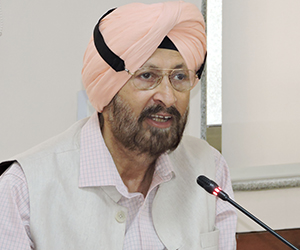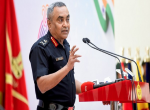The Ministry of Defence (MoD) appears to have rejected the proposal of the Naresh Chandra Committee on Defence Reforms to appoint a permanent Chairman of the Chiefs of Staff Committee (CoSC). This is a retrograde step as the proposal itself is a watered down version of the original recommendation of the Group of Ministers (GoM) of 2001 to appoint a Chief of Defence Staff (CDS).
For many decades, defence planning in India has been marked by knee jerk reactions to emerging situations and haphazard single-Service growth. The absence of a clearly enunciated national security strategy, poor civil-military relations, the lack of firm commitment of funds for modernisation beyond the current financial year and sub-optimal inter-service prioritisation, have handicapped defence planning. Consequently, the defence planning process has failed to produce the most effective force structure and force mix based on carefully drawn up long-term priorities. With projected expenditure of US$ 100 billion on military modernisation over the next 10 years, it is now being realised that force structures must be configured on a tri-Service, long-term basis to meet future threats and challenges.
In 1999, the Kargil Review Committee headed by the late Mr. K Subrahmanyam had been asked to “…review the events leading up to the Pakistani aggression in the Kargil District of Ladakh in Jammu & Kashmir; and, to recommend such measures as are considered necessary to safeguard national security against such armed intrusions." Though it had been given a very narrow and limited charter, the committee looked holistically at the threats and challenges and examined the loopholes in the management of national security. The committee was of the view that the “political, bureaucratic, military and intelligence establishments appear to have developed a vested interest in the status quo.'' It made far reaching recommendations on the development of India’s nuclear deterrence, higher defence organisations, intelligence reforms, border management, the defence budget, the use of air power, counter-insurgency operations, integrated manpower policy, defence research and development, and media relations. The committee’s report was tabled in Parliament on February 23, 2000.
The Cabinet Committee on Security appointed a GoM to study the Kargil Review Committee report and recommend measures for implementation. The GoM was headed by the then Home Minister L K Advani and, in turn, set up four task forces on intelligence reforms, internal security, border management and defence management to undertake in-depth analysis of various facets of the management of national security.
The GoM recommended sweeping reforms to the existing national security management system. On May 11, 2001, the CCS accepted all its recommendations, including one for the establishment of the post of the Chief of Defence Staff (CDS) – which has still not been implemented. The CCS approved the following key measures:
- Headquarters Integrated Defence Staff (IDS) was established with representation from all the Services. The DG DPS was merged in it.
- The post of Chief of Defence Staff (CDS), whose tasks include inter-Services prioritisation of defence plans and improvement in jointmanship among the three Services, was approved. However, a CDS is yet to be appointed.
- A tri-Service Andaman and Nicobar Command and a Strategic Forces Command were established.
- The tri-Service Defence Intelligence Agency (DIA) was established under the COSC for strategic threat assessments.
- Speedy decision making, enhanced transparency and accountability were sought to be brought into defence acquisitions. Approval of the Defence Procurement Procedure (DPP 2002) was formally announced.
- The DPP constituted the Defence Acquisition Council (DAC) and the Defence Technology Board, both headed by the Defence Minister.
- Implementation of the decisions of the DAC was assigned to the Defence Procurement Board (DPB).
- The National Technical Research Organisation (NTRO) was set up.
- The CCS also issued a directive that India’s borders with different countries be managed by a single agency – “one border, one force” and nominated the CRPF as India’s primary force for counter-insurgency operations.
Decision making is gradually becoming more streamlined. The new Defence Planning Guidelines have laid down three inter-linked stages in the planning process:
- 15 years Long Term Integrated Perspective Plan (LTIPP), to be drawn up by HQ IDS in consultation with the Services HQ and approved by the DAC.
- Five Years Defence Plans for the Services (current plan: 2007-12), including 5-years Services Capital Acquisition Plan (SCAP), to be drawn up by HQ IDS in consultation with the Services HQ and approved by the DAC.
- Annual Acquisition Plan (AAP), to be drawn up by HQ IDS approved by the DPB. Budgetary allocations for ensuing the financial year (ending March) are made on the basis of the AAP.
Ten years later, many lacunae still remain in the management of national security. The lack of inter-ministerial and inter-departmental coordination on issues like border management and centre-state disagreements over the handling of internal security are particularly alarming. In order to review the progress of implementation of the proposals approved by the CCS in 2001, the government appointed a Task Force on National Security led by Mr. Naresh Chandra, former Cabinet Secretary. The task force has submitted its report, which has been sent for inter-ministerial consultations.
Conclusion
A fluid strategic environment, rapid advances in defence technology, the need for judicious allocation of scarce budgetary resources, long lead times required for creating futuristic forces and the requirement of synergising plans for defence and development, make long-term defence planning a demanding exercise. The lack of a cohesive national security strategy and defence policy has resulted in inadequate political direction regarding politico-military objectives and military strategy. Consequently, defence planning in India had till recently been marked by ad hoc decision making to tide over immediate national security challenges and long-term planning was neglected. This is now being gradually corrected and new measures have been instituted to improve long-term planning.
It is now being increasingly realised that a Defence Plan must be prepared on the basis of a 15-year perspective plan. The first five years of the plan should be very firm (Definitive Plan), the second five years may be relatively less firm but should be clear in direction (Indicative Plan), and the last five years should be tentative (Vision Plan). A reasonably firm allocation of financial resources for the first five years and an indicative allocation for the subsequent period is a pre-requisite.
Perspective planning is gradually becoming tri-Service in approach. It is now undertaken in HQ IDS, where military, technical and R&D experts take an integrated view of future threats and challenges based on a forecast of the future battlefield milieu, evaluation of strategic options and analysis of potential technological and industrial capabilities. Issues like intelligence, surveillance and reconnaissance, air defence, electronic warfare and amphibious operations, which are common to all the Services, are now getting adequate attention. However, unless a CDS is appointed to guide integrated operational planning, it will continue to be mostly single-Service oriented in its conceptual framework.
Published Date: 4th July 2013, Image Source: http://static.ibnlive.in.com








.jpg)

Post new comment